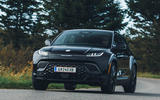The Fisker Ocean may well be designed in California, but it’s built by Magna Steyr in Austria.
Which is why it may look, somewhat unexpectedly, like a compact, European-flavoured SUV.
In the metal, it’s a little like a slightly squatter, stretched Range Rover Evoque - but it certainly escapes the awkward proportions of so many of its electric rivals, and is distinctive enough to stand out in its own right.
It's a good-looking car, this - just as you'd expect given the reputation of the eminent car designer whose name adorns its model badge.
But while the Ocean’s wide-stanced, sharp-featured styling is typically seen on cars with ‘premium-brand’ associations, Fisker actively avoids such a classification.
It sees customers moving away from the automotive nameplates associated with consumerist ‘aspiration’ over the past half-century and towards new ones that better embody their personal values.














































